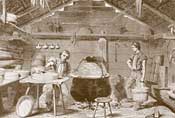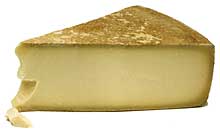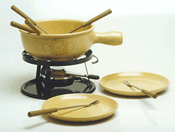Welcome to the tenth
issue of the Teddington and Kew Cheese Wire. We have all recovered
from a hectic Christmas and New Year season . Our pre-order and
collection service for our local customers was well received,
allowing us to reserve their favourite cheeses and saving them
the hour long queues which sometimes develop during this busy
time. Many thanks for to those who preferred to queue (or forgot
to pre-order) for their happy Christmas spirit, it never fails
to amaze us how cheerful our Christmas queuers are. Next year
we are considering handing out Carol sheets and lanterns.
Our mail order service was equally as busy and
we were able to keep our order line open until a week before Christmas.
Many apologies to those who tried to place orders in the final
few days before Christmas but by this time we had reached our
maximum capacity and stocks of our farm-house cheeses had already
been exhausted. We do send out reminders (by post and e-mail)
to all those on our mailing list encouraging them to place orders
early and we will do the same again next Christmas. Please do
not hesitate to contact us should you wish to be added to our
mailing list.
This Millennium year is promising to be as exciting
as the last and we hope to bring you many more exciting cheeses
and products during the year.
|

Inside
Features
Oh!! for the joy
of real butter
Have you got a cheesey name?
Cheese
Focus
Gruyere
Recipe
Making the perfect Fondue
Tools
of the Trade
Scotch Hands
Competition
Paint a picture
and last months competition winner
|

Have you got a cheesey name?
Nowadays
we all have both a first name and surname by which we are known.
Many hundreds of years ago things were very different. Because
the majority of people could neither read or write and forms
onto which to put our names did not exist, people were simply
known as Tom or John. Sometimes a second name would be used
referring either to a family name (in Scotland they would use
the prefix Mc or Mac which basically means 'son of') or to their
trade.
Some
trades are easily recognised such as Carpenter, Baker or Potter.
As far as cheese is concerned there are names with obvious connections
such as:
Cheeseman
- maker or seller of cheese
Cheesewright - maker or
seller of cheese Cowherd
- from cowherd
Coward - also from cowherd
Cowley - from the cow pastures
Shepherd - one who tended
sheep. Cheese made from ewes' milk was the norm before cattle
were introduced so extensively.
and
some less obvious ones:
Byers
- from the cow sheds
Boothby - from the farm
with cow byres
Day - from dairy-maid or
dairy-man both from dey-ery
Furminger - derived from
the old word 'furmage' meaning cheese (now fromage in French)
Ringer or Wringer
- a cheese press used to be called a wringer and was used to
squeeze the whey from the curds
The
old word 'wick' means a group of buildings where dairy farming
was carried out and gives us...
Batherick
- from the dairy farm where the bladderwort grows
Denwick - from the dairy
farm in the valley
Fenwick - from the dairy farm in
the fen
Howick - from the dairy
farm on the 'hough' (Lancashire) Sedgewick - from the dairy
farm in the reed beds
Wicken - from the dairy
farm
Witcher - a dweller at the
dairy farm
back
to top
|
|
Cheese
Focus Cheese
Focus Cheese Focus

Gruyère Reservé
Switzerland |
|
Gruyère was first made in
the dairying canton of Fribourg during the 12th century
and took its name from the town of Gruyère.
Old records exist which show that Gruyère was
used by farmers to pay tithes to the monks of Rougement
Abbey. During the 16th century it was exported to
France and Italy and although it has been extensively
copied it is still hard to beat the genuine Swiss
Gruyère. The cheese travels well since it retains
its quality for a very long time - the Swiss call
it 'the cheese that never gets tired' and also refer
to it as 'the grand old lady'. Since cheeses are large,
each using over 400 litres of milk, they tend to be
made by groups of farmers working in cooperatives.
Gruyère is made using 'unpasteurised' milk
from the black and white Fribourg breed of cow. Although
it is often referred to as 'unpasteurised' milk it
is in fact heat-treated. This process is not as severe
as pasteurisation and consequently much of the natural
flora in the milk is preserved and this yields delicious
flavours in the resulting cheese.
The excellent melting and cooking
properties of Gruyère are a result of the process
used to make the cheese - Gruyère is a 'hard-pressed
cooked cheese'. The junket is cut into small cubes
(junket is the name given to the blancmange-like mass
formed when rennet has been added to milk, which then
coagulates and sets) which begin to release the liquid
within them, called whey. The drying cubes, called
curds, then float around in the whey. The mass is
heated and is held for a time at a set temperature.
During this time the curds shrink to the size of peas
and become harder.
|
When the cooked curds reach a certain
hardness and size the whey is drained off and the
curds placed into a mould and put under a press. High
pressures are used to produce a dense and heavy cheese.
Gruyère cheeses are matured
in cellars and are regularly turned. Their rinds are
always kept moist to prevent cracking. The rind becomes
reddish-brown and tough, the paste is yellow with
the occasional pea-sized hole. The cheese is sometimes
sold at five months when it cuts easily, but the flavour
is still mild. At least twelve months of maturation
is needed to yield its magnificent nutty flavour.
The Gruyère stocked at The Teddington Cheese
is matured for over 12 months - it is known as Gruyère
Reservé.
The great chefs of the last few centuries
have used Gruyère extensively in their recipes.
The Swiss have used it to create one of their most
famous national dishes - the fondue. Because of Gruyère's
excellent melting properties (melting smoothly and
without the 'stringy' texture of Emmental) it has
become invaluable for making gratins, for grilling
and in soups. Because of its success in the kitchen
it is unfortunate that it is often overlooked when
deciding on a cheeseboard. Gruyère Reservé
makes an excellent contribution to a cheeseboard and
is best enjoyed with a crisp white or light red wine.
Each cheese measures approximately
1 metre in diameter, is 10cm thick, weighs from 20
to 45kg and has a fat content of 48%.
|
| £1.21
per 100g, £1.42 per quarter or Whole wedge (4kg)
£10.63 per kg |
|
|
|
Oh!! for the joy of real
butter
|
|
There are few things I enjoy more
than hot toast generously topped with melting farm-house
butter. Unfortunately, I am bombarded with the latest thinking
that I should be eating this or that brand of highly processed
butter substitute all of which proclaiming to taste like
real butter but failing miserably to do so. I would like
to return to a simple common sense approach - there is nothing
more wholesome than unadulterated milk which is churned
to produce unbeatable farm-house butter. Eaten as part of
a balanced diet with exercise it can't fail to provide nothing
but real pleasure. Of course, I can never stop at just one
slice of hot buttered toast but I am willing to accept the
penalty of having to run an extra mile.
How butter is made Butter is obtained by churning
cream. The cream can be either fresh or slightly soured although slightly
soured cream tends to give better results. Cream is soured using a
special butter starter and once introduced it is allowed to stand at
21C for 12 hours. After ripening the cream is cooled to 4.5 to 7C for
several hours to allow the fat to harden. The cream is then allowed
to warm to 10 to 18C, 10C in the warmer weather and 18C in cooler weather
and is poured into a butter churn. Paddles slowly agitate the cream
causing it to thicken and separate into butter grains and buttermilk.
Cold water at 10C is then added and then it is agitated again. Added
water is necessary to help the cream to 'break' but the water should
not exceed 25% of the total volume of cream. Churning continues until
the butter granules are about the size of wheat grains. The buttermilk
is then poured off and the remaining butter grains washed with cold
water by chuuning them together. The water is then run off. This washing
process is very important since it ensures that all the butter milk
is washed out of the butter. Otherwise the butter will not keep and
go rancid.
|
| With the wash water drained off,
the butter grains mat together and can be removed from the
churn then placed onto a wooden board. The board is sloped
a little to aid remaining water to drain away. The butter
is patted with the scotch hands to press out the water. It
is patted into a thin layer, folded over and then patted again.
Salt can also be sprinkled onto the butter at the ratio of
0 to 2 teaspoons per 500 grammes (or per pound) according
to taste. The butter is finally patted into shape and then
wrapped in waxed paper and then stored in a cool place. |
|
Tools of the Trade
|
|
|
|
Scotch
Hands
|
|
|
Farm made butter uses the cream directly
from whole milk whereas commercially made butter is made
by extracting small amounts of cream from whey, a by-product
of cheese-making, using large centrifuges.
At The Teddington Cheese we sell two types
of real unpasteurised farm-made butter, Montgomery's slightly
salted and Normandy unsalted.
|
|
|

Above:
Montgomery’s salted butter £1.46 per 250g pack
Left:
Normandy unsalted butter £0.76 per 100g, £0.86
per quarter. 1/4 churn (1.25kg) £6.46 per kg
|
back to top
|
|
|
|
Goodbye eggs
Over the past few years we
have been supplied fresh free-range eggs by Kevin and Alison
Blunt of Greenacres Farm in West Sussex together with their
goats' milk cheeses. Kevin and Alison and have gradually
been reducing their egg laying capacity in favour of providing
further grazing for their goats. It
is with regret that their production has now ceased and
we are now searching for a new 'true' free range egg supplier
with happy hens.
|
|
Fondue and raclette sets
for sale and hire

For Sale
Swiss 'Alpe' fondue set £60.00
(complete with pot, stand, burner, 6 forks and 6 plates)
Raclette 'Ambiance' for half cheeses £160.00
Raclette ' Party' for quarter cheeses £110.00
Hire service
(for those who live close to our Teddington and Kew shops)
Fondue set £10.00 per day
Raclette 'Ambiance' £8.00 per day
Raclette 'Party' £5.00 per day

|
|
|
Competition
Paint a Picture
Many children visit our shops and our web site
regularly to help choose cheeses for their families. In this issue
we are having a competition to involve our younger readers. The
aim is to paint or draw a picture related to cheese or cheese
making. It could be a picture of a milk cow, sheep or goat, a
picture of cheese being made or enjoyed or simply a picture of
a cheese itself. The winning picture will be printed in black
and white on the front cover of the next issue of the Teddington
& Kew Cheese Wire and in full colour on our internet version of
the Cheese Wire which is sent to customers all over the world.
Entrants must be under the age of 16.
All entries must be received by 15th April 2000
(please include your name, address and telephone number). The
winner will receive the 'Cheeses for May' selection from The Teddington
Cheese Club. Entries will be accepted by post or e-mail.
Competition now over
See issue 11 for details of the winning entry
The winner
of the last competition, Celebrity Cheese, was Clive Nutton of
Shipley, West Yorkshire with:
Gjetost
is the Bjork of cheeses, outwardly peculiar and inwardly odd.
The combination is an unexpected polar symphony, an aurora borealis,
hard to explain.
Thank you
to everyone who entered our competition.
back to top
|
|
THE
PERFECT FONDUE
|
|
Fondue
started life in Switzerland as a rustic affair using leftover
scraps of cheese, and although nowadays the ingredients
may be more sophisticated it is still a sociable and down-to-earth
dish with everyone sharing from the same pot. The famous
Swiss cheeses Gruyere, Emmental and Appenzeller remain the
most popular fondue ingredients but good results can also
be achieved by adding Comtè, Beaufort, Raclette or
Tete de Moine to the mixture. We are often asked for advice
on how to prepare the perfect fondue, and so here is a classic
recipe.
|
Swiss
Fondue
(serves 4)
Ingredients:
1/2
clove garlic
500g Gruyere
250g Emmental
150g Appenzeller
350ml/1/2 bottle dry white wine
1 teaspoon fresh lemon juice
3 teaspoons cornflour
1 1/2 tablespoons kirsch
pinch of nutmeg
freshly ground pepper
|
|
To
prepare:
Rub
the inside of your fondue pot with the cut surface of the
garlic. Grate the cheeses and put them in the pot. Mix the
cornflour with the lemon juice and then add to the cheese
together with the wine. Heat the mixture gently on your
kitchen stove until the cheese melts, stirring frequently
to achieve a smooth consistency.
Take
care not to let the cheese boil (if your fondue pot is the
ceramic type do this part in a saucepan and then transfer
the melted cheese back into the fondue pot). Stir in the
kirsch, pepper and nutmeg and then place the mixture over
the burner on the table.
To
serve:
Spear
bite-sized cubes of bread on to a fork and dunk them into
the cheese. Stir until the bread is well-coated, then remove
whilst rotating your fork to stop the cheese from dripping.
Give the mixture a stir every time you dip into it and it
will remain creamy down to the very bottom.
Useful
tips:
•
If the fondue is too thick, beat in a little warmed wine
or kirsch.
•If the fondue is too thin, stir in some grated cheese
over medium heat. If you have run out of cheese, add a little
cornflour mixed with some white wine.
• If the cheese and wine separate, return to the stove
and beat with a whisk over a high heat. If you keep on stirring
as you eat, the fondue should not separate.
• Make sure everyone drinks plenty of wine.
• Get someone else to wash up the fondue pot.
|
|
All articles © www.teddingtoncheese.co.uk
|